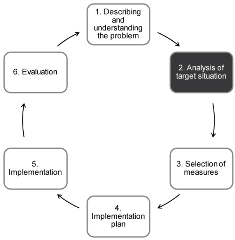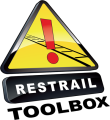 Once the problem has been defined globally, the next step should include the detailed understanding of a target situation where measures are considered for implementation. Information can be collected from different data sources such as: behaviour reports, accident / suicide investigation report (if available), specific incident reports, or CCTV footage.
Once the problem has been defined globally, the next step should include the detailed understanding of a target situation where measures are considered for implementation. Information can be collected from different data sources such as: behaviour reports, accident / suicide investigation report (if available), specific incident reports, or CCTV footage.
The characteristics of the specific location should be considered: the environment, spatial configuration, history of the site, pre-existing measures and specific constraints. At this stage you can use relevant characteristics from a list to obtain more data (based on the categories within e.g., location – station, crossing, etc.), review of existing measures in targeted locations, conduct field visits, check the safety record, brainstorm with RU / IM experts, etc. Try to figure out what is needed at that specific site to eliminate / diminish the target incident.
| Actions | Questions to be answered | Issues to be considered |
|---|---|---|
| Definition of target location | What is the exact location in question? | -* track address / sector -* particular station -* boundaries of targeted site (map) -* any particular configuration of the location |
| Problem behaviour | What do the statistics of suicides and attempted suicides tell about the problem? | -* distribution in time -* exact locations -* information of details |
| What do the statistics of trespassing accidents tell about the problem? | -* distribution in time -* exact locations -* by severity -* other details | |
| What is the frequency of trespassing? | -* counts of trespassing needed, if information is not available | |
| Is it possible to identify the routes used by trespassers? | -* point of entry and point of exit -* trespasser flows per route | |
| What are the motives of problem behaviour? | -* observations -* interviews of trespassers -* interviews of local residents -* questionnaire to local residents | |
| What are the targeted people? | -* children playing -* children going to school -* youngsters loitering -* vandalism -* adult commuters -* people during their free time activities (e.g. walking their dog, taking photographs) -* people going to / coming from sportive activities on stadiums -* people going shopping, coming home from a bar, etc. -* people with mental problems -* people with suicide intent prone to choose the railways as a means | |
| Existing measures | What are the details of existing measures? | -* lack of present safety measures -* for each measure separately -* what, where, when implemented -* current status? -* need of maintenance? |
| What is the estimated effectiveness of existing measures? | -* for each measure separately -* does it work as intended? -* if not, why? -* if studies do not exist, provide expert estimate | |
| Definition of the objectives of new measures | What are the targeted incidents? | -* suicides -* suicide attempts -* trespassing accidents -* trespassing behaviour |
| What is the targeted behaviour? | -* exactly where within the target location the targeted behaviour occurs -* is it focused in certain time periods (e.g. summer or night) -* does the targeted behaviour have some specific features (e.g. loitering on platforms, concerns especially teenagers etc.) | |

